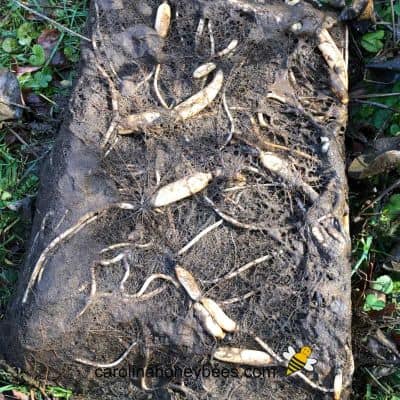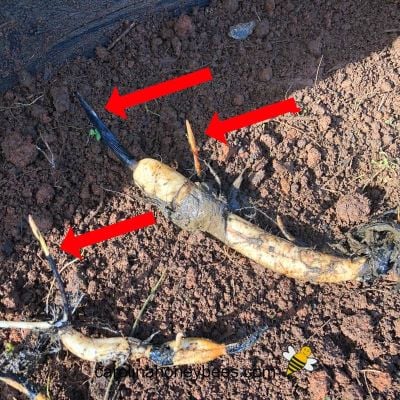Growing Lotus Tubers in the Bee Garden
Sharing your garden with all the bees, butterflies and other pollinators is a true joy. It gives us a look into the world of these fascinating insects. One of my favorite activities is developing a water feature and growing Lotus tubers in my bee garden. These flowers seem magical to me. And, the blooms are usually very large and quite impressive in the garden.
Lotus Flowers for Bees

Lotus plants are different than the other types of flowers in my garden. Perhaps that is part of the appeal. Their large flat green leaves are intriquing – even before the bloom appears.
They are slow to wake up in the Spring. But, as Summer arrives tall stalks appear with one giant bud. These beautiful plants have been a part of my water garden for years. Although drawn to this plant by its unique physical beauty, I have another reason for growing lotus.
Bee pollinators (my honey bees) absolutely adore lotus blooms. It is not unusual to see a bee “traffic jam” inside one of the huge blossoms. All are busy gathering food for the hive.
Bees use pollen as a protein source needed to raise young bees. Plant nectar is their energy source and is used to make honey. The lotus plant offers both to those willing to do the work.
Starting Lotus Tubers
Lotus can be started from seeds but that is quite an undertaking. I would not recommend that option for any but the most advanced gardener. For most of us, lotus plants are easiest to grow from tubers.
There are many varieties and lotus tubers are not inexpensive. I paid $20 each for my tubers – over 20 years ago. Once they are established, these plants are not a lot of trouble.
However, the tubers have growing points and if you break them off – it is done! They also must be planted while dormant and that usually means during Winter ! If you want to try growing a lotus for your bee garden this year, be sure to follow the directions you are sent by the grower.
My lotus are grown in large tubs or pots instead of being placed directly in the small ponds. The tubers will run wild given the chance and I would rather keep them contained. These containers are then usually buried in the ground to hide the exterior and give the roots some protection from freezing weather.
Winter Lotus Maintenance
Other than keeping the soil in the container wet, and adding a little pond plant fertilizer – established lotus are rather carefree. I just leave my alone and enjoy. However, there comes a time when maintenance is required.
Every 2 years or so, I will heave the root ball out of the growing pot and divide my lotus tubers. It is a smelly, dirty job but important to maintaining nice blooms.
This division helps to maintain a vigorous, blooming plant. And, I have some extra tubers to sell or share with others.
This means dividing lotus plants during January. Pond or tub water can be rather cold in January – even here in upstate South Carolina.

Dividing Dormant Lotus Tubers
My first task is to work with the plant I have in a small water feature. It is Chawan Basu a smaller variety of lotus.
The mucky job begins with the removal of most of the water from this particular water feature so I can reach the tub with the plant.
This lotus is grown in one of those plastic cement mixing tubs. It is a shallow container (which is desirable) and has rounded corners. A Lotus plant can suck up a lot of water during the Summer.
Therefore, I created a small pond about 4 ‘ x 4 ‘ and 2 ‘ deep to keep this plant well watered. A great idea until it is time to remove the heavy wet pot ! I had to borrow hubby’s tractor but you can do it with a friend.

Removing Tuber Container
With the help of our tractor, I moved the heavy pot of lotus tubers to a spot near the compost pile. This may look like a goopy mess and some of it is but there is some treasure inside too.
Dumping the mass out of the container is a bit risky because I will break some good tubers. However, it is too heavy to do otherwise.
Once, the plant material is dumped from the container – little soil remains. Instead, there will be a tight mass of roots and assorted rotted junk. Then, I see it. A beautiful if somewhat yucky sight, lotus tubers on the bottom of the root mass.
Each one of these tubers has the capacity to grow into a blooming lotus plant. Which will provide food for my bees in the years to come. And a beautiful sight for me to enjoy in the bee garden.

Choose the Best Dormant Tubers
I harvest the largest tubers and do not try to save every little one. I could save the smaller pieces but each one requires a growing pot and attention.
Not having the space or time for that – I choose the largest tubers and hopefully those with more than one growing point (in case I break one while planting it !).
Care must be taken to not break the growing point on the end. This work requires caution and getting your hands dirty. Handle those tubers like raw eggs – very gently.

These tubers are from another lotus tub in my bee garden area – Mrs Perry D Slocum. It is a larger type of plant and you can easily see the “growing tips”.
Once the root mass has been dumped out of the tub, I proceed with caution to harvest the larger tubers too without breaking off growing tips.
The growing tip is the beginning of a new lotus plant. If you break it off, the tuber will not grow another! You must be VERY careful.

Prepare New Soil and Plant
Now it is time to refill my tub or plant container that will hold the lotus roots. I use about 6″ of fresh soil (red mud – in my area). Potting soil is not a good idea – it will float out. Opt for heavy soil when possible.
Gently place 2 lotus tubers in the center of the pot. Why 2? In case, I break the tips off one without realizing it. This is an important point – weighing down the tuber.
Do not bury the tubers, lay them on the soil. You want them to stay in contact with the soil. But guess what? Tubers float!
Therefore, gently weigh down the tubers with a rock to keep them in contact with the soil. Take care to leave the growing tips exposed.
Then, the original tub container is carefully lowered into the small water feature. Water is added until the pond is deep enough to cover the container, tubers and growing tips.

I could completely fill the small pond if I wished but I will leave it for the rain to complete my work. Now we have to wait for warm weather. Nothing will happen right away.
The tuber will not begin to grow until warmer temperatures arrive. Don’t assume they are dead – as long as they don’t rot – you have a chance of success.
Admittedly, this is not a very pretty sight to behold at present. But… it will be. In a few months, the lotus plant will begin to grow.
Roots will be established in the new soil, a few floating leaves will emerge and lie flat on the surface. Eventually, standing leaves will appear and give this plant a distinctive look.
Then one day, a stalk with a large bud will appear. It will grow larger and larger until… the beautiful lotus bloom will open to greet the day.

Beautiful Lotus for Me and the Bees
Most of my small water features also serve as a water source for the bees. Providing water for your hives is a great way to keep them closer to home.
Provide a shallow area with pebbles or rocks so your bees can safely land and drink. This enhances the safety of any honey bee garden.
Consider trying a couple of lotus in your bee gardens this year. You can order tubers online and that is the best way to get started with this extraordinary plant.
There are many ways to grow lotus, divide lotus and even “eat lotus”. I am not an expert in lotus propagation. However, this method of dividing lotus tubers works for me. When you are planning your bee gardens this year, consider giving this unusual plant a try.
If you are really want to try one of these unique plants – and miss the dormant season, you may find one growing in a pot at a local garden center. Don’t disturb the roots until the plant is dormant.

